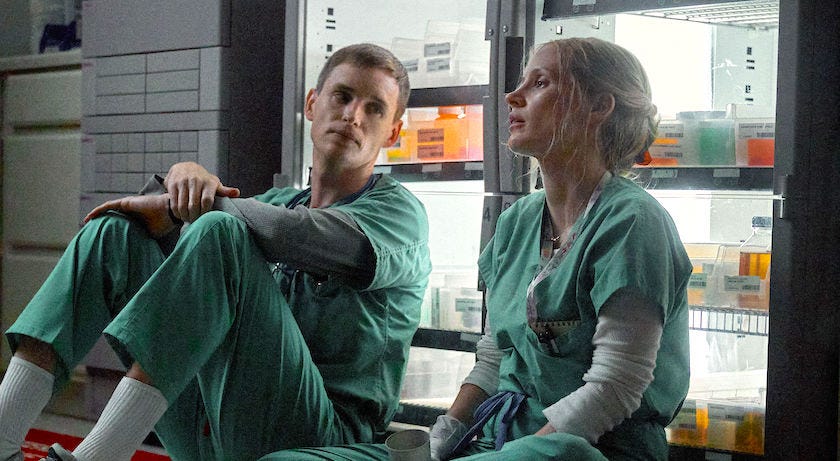The Good Nurse
Two Oscar-winning performers and top-drawer filmmakers do their best with a stolid medical whodunit about a nurse who may be killing his patients.
I remember when “American Gangster” was coming to theaters and seemed like a surefire outstanding drama: Oscar-winning lead actor, Oscar-winning supporting actor, Oscar-winning screenwriter, and one of my favorite directors (who should’ve gotten an Oscar several times over) at the helm. It stank.
I bring this up not to rehash old movie grudges — though I’m fond of those — or to designate “The Good Nurse” a piss-poor movie. It’s not.
But a sterling pedigree is no guarantee of success, in filmmaking or in any endeavor, and even the presence of Academy Award winners Jessica Chastain and Eddie Redmayne, not to mention some top-drawer filmmaking talent, can’t save this medical whodunit from stolid mediocrity.
Based on a true story chronicled in the book of the same title by Charles Graeber, it’s the tale of two harried nurses who become fast friends. Amy Loughren (Chastain) is a single mom who’s relatively new at Parkview Hospital in New Jersey and is waiting for her one-year anniversary date to qualify for health insurance. Meanwhile, she is hiding a heart condition that is knocking her down on the job and may eventually require a transplant.
(Sound like typical Hollywood BS? Healthcare workers often have some of the worst coverage.)
New arrival Charlie Cullen (Redmayne) seems like a godsend to Amy and the other nurses on the ICU night shift. He’s an experienced nurse, hardworking and empathetic with patients, and is sweet and supportive to boot. Her work life instantly becomes easier to manage, and Amy quickly bonds with Charlie.
They are both single parents with two young daughters. In a typical movie, romance would inevitably ensue, but I credit the filmmakers with not falling into the usual cliche traps. Their relationship is more brother and sister, the nice kind where they get along and help each other, with a touch of catty humor.
Director Tobias Lindholm wrote the excellent film “Another Round” from a couple of years ago, and screenwriter Krysty Wilson-Cairns is a hot talent with her own Oscar nomination (“1917”) and high-profile credits under her belt including “Last Night in Soho.”
Unfortunately, the ICU starts experiencing a rash of patients who suddenly code-blue, seemingly for no reason. They manage to save a lot of lives but a few pass away, including Ana Martinez, an old woman who seemed on the mend.
The hospital bureaucrats, led by Kim Dickens as a former nurse turned mercenary problem-handler, turn the case over to the cops, cautioning they’re only doing so at the CYA urging of their lawyers. The body was actually cremated weeks earlier, so there’s literally no corpus to habeas, and the two detectives on the case (Nnamdi Asomugha and Noah Emmerich) are continually confounded at the lack of documentation and support they’re provided.
Their instincts say something’s wrong, so they set up interviews with all the medical crew including Amy, who lets slip that the presence of insulin in Ana’s blood probably caused her death. This leads to eyes turning toward Charlie.
It’s right around here, that “The Good Nurse” shifts from being a character drama to a whodunit, that the movie loses blood pressure. It’s the usual crime procedural stuff with the cops on the trail, shoeleather show-ups at homes or offices and griping about lieutenants and prosecutors being too timid to take on the powerful do-badders.
My eyes glazed.
Chastain is the focal point and main character, so we’re always seeing Redmayne’s Charlie through her eyes. He comes across as this totally vanilla, dweebish dude, a nice-guys-finish-last type who couldn’t possibly be a mass murderer. More vexing, as things zero in on the extent of the crimes, we never get a hint at why Charlie might have done such horrendous things.
By keeping us outside of his mind, Charlie remains a bland cipher, not a figure to be feared or defended but simply there, a box full of questions that never gets satisfactorily answered.
It would’ve been more interesting if, say, Amy had stumbled across the deaths herself and was the one carrying on her own little Nancy Drew investigation, probing deeper into the facts while struggling with the idea of her friend and fellow caregiver being a remorseless killer.
That would’ve run afoul of the historical record, but made for a better movie. Even as someone who regularly groans about how movies fudge the facts, this would’ve been a ripe occasion to veer off the steady path and plunge into the thickets.





